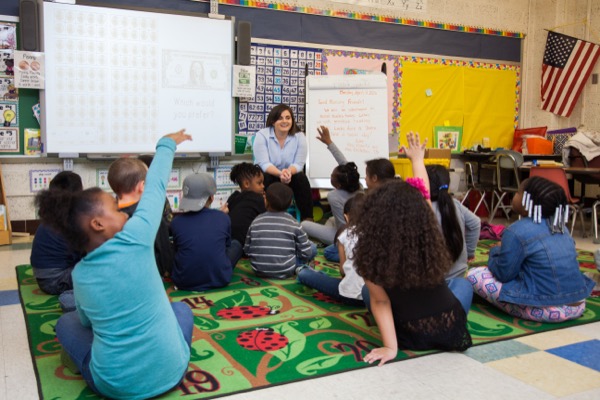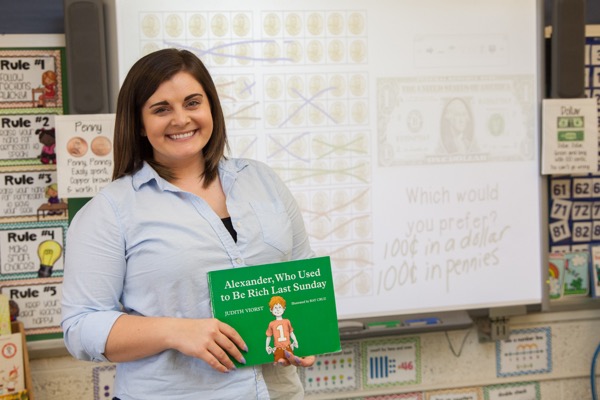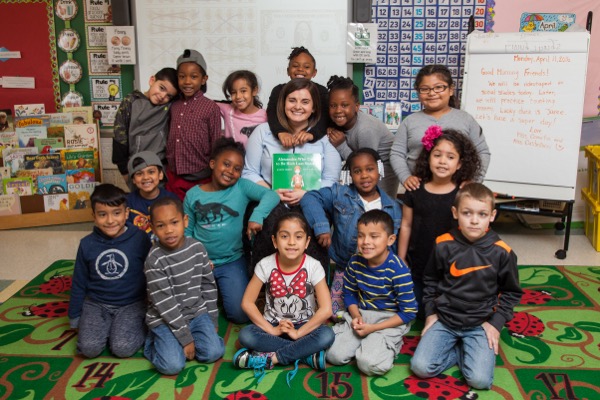

Economics for kids
UD's Bonnie Meszaros creates economics lesson plans inspired by children's books
1:41 p.m., April 18, 2016--Research suggests that our ideas about money are well formed by age seven.
If this is the case, Bonnie Meszaros suggests, then saving economic education for the teen years is a big mistake.
Campus Stories
From graduates, faculty
Doctoral hooding
“It’s too late if we wait until they’re high school students,” said Meszaros, associate director of the Center for Economic Education and Entrepreneurship (CEEE) at the University of Delaware’s Alfred Lerner College of Business and Economics.
Meszaros and the CEEE have worked to bridge this educational gap with the creation of the groundbreaking Economics for Kids curricula for kindergarten and first grade. These interactive lessons make economic concepts fun and accessible for young students.
“A children’s book goes along with every single lesson,” explained Pleasantville Elementary School teacher Nicole Belasco. “So it’s easier for the students to relate to, because they can connect the lesson back to a character or a specific situation in the story.”
When learning the concept of scarcity, for example, students read Monster Musical Chairs and then actually play musical chairs to help visualize scarcity.
“The chairs represent goods that they want,” Meszaros said. “But, of course, if they can’t get a chair, they can’t satisfy their want.”
When learning about producers and consumers, students read The Little Red Hen Makes Pizza. They then become producers and consumers themselves by creating and using bookmarks that help them to develop their language arts skills.
Pleasantville teacher Michelle Cometa, who has used Economics for Kids with both kindergarten and first graders, said that the lessons encourage hands-on learning.
And Cometa has witnessed the efficacy of this multifaceted approach as her students’ growing understanding of economics has become evident in their daily lives.
For example, one week Cometa’s class learned about the importance of having a savings goal from an interactive Economics for Kids lesson based on the children’s book Bunny Money.
Soon after, Cometa received a visit from a student whose mother had recently given her $10. The student decided to “be a good citizen” and donate some of her money to a homeless shelter, then discussed her long-term savings goal of $100.
“I’m confident that she has learned that skill and is now applying it,” Cometa said.
Positive results like these have led to Colonial School District adopting the Economics for Kids kindergarten curriculum as the district’s official economics unit, taught by all kindergarten teachers, with plans to expand to first grade as well.
An interactive approach
Nick Baker, supervisor of curriculum and instruction for Colonial School District, described Economics for Kids as an educational game-changer.
“A lot of us learned economics using a textbook, or it was sometimes a dry subject that students couldn’t relate to,” Baker said. “This has really opened up the world of the student in a sense that they can make those personal connections. And it makes economics come alive.”
“The activities are very hands-on and engaging. So they encourage the students to not only relate to the material, but also interact with one another and be fully engaged.”
He added that, in addition to holding students’ interest, Economics for Kids lessons help students to learn holistically, building mastery in more than one subject at once.
“These lessons have allowed us to bridge connections to multiple content areas,” Baker explained, as the lessons effectively link language arts, social studies and math.
“It’s allowed the teachers that opportunity to have meaningful discussion around economics and about economic principles as well, and extend it beyond the traditional social studies time period during the day.”
The results of this approach can be seen in the Colonial district’s common assessments.
“What we’ve seen is an increase in economic proficiency measured by those assessments,” Baker said. “That tells me the students are learning the concepts very well. I’m seeing more of that direct connection.”
And these materials are filling a serious void, he said, as textbook companies rarely develop educational products that meet the unique social studies standards of small states like Delaware.
However, he continued, this small state status has allowed districts like Colonial to develop strong partnerships with UD and the CEEE to achieve common goals.
The Economics for Kids package is also unique in that each year’s curriculum is self-contained in a binder holding all necessary materials, activities and assessments.
With the CEEE also offering teachers training in how to use the materials, each lesson is essentially a one-stop shop.
“From a teacher’s perspective, we have such limited time to find materials that we need,” Belasco said. This makes it particularly useful that Economics for Kids is “literally everything I need in a binder. The book is there; the materials are there; the lesson plan is there; the assessment ideas are there. And it hits the standards.”
Baker now hopes for the creation of a second-grade version of Economics for Kids, and thinks that other content areas should consider following this curriculum pattern.
“I’m eager to see how it evolves as we move along in the grades,” said Baker.
“This allows us to focus on economic citizenship and economic decision-making,” he continued. “It allows us to broaden that definition of being a good citizen.”
Article by Sunny Rosen
Video by Ashley Barnas
Photos by Ambre Alexander Payne













